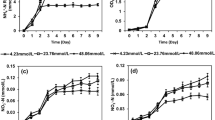Abstract
Rhodopseudomonas palustris, a purple non-sulfur bacterium, was recently found throughout the water column in Lake Kinneret. It was demonstrated to be of a versatile nature, growing under both aerobic and anaerobic conditions at different light intensities. A comparison of C-acetate uptake byR. palustris andChlorobium phaeobacterioides, a green sulfur bacterium, showed that, under identical growth conditions, C-acetate assimilation byR. palustris was greater. Furthermore, C-acetate uptake forR. palustris was greater than C−CO2 uptake at all light intensities. Depending on the prevailing conditions, acetate can be used byR. palustris as both an electron donor and carbon source. Malate synthase was used as an indicator of activity of the glyoxylic acid cycle. It was found that enzyme activity was higher (i.e., acetate was used mainly as a carbon source) under anaerobic conditions, in the dark, or in the absence of HCO −3 . Acetate was used preferably as an electron donor under photosynthetic microaerophillic conditions.
Similar content being viewed by others
References
Albers H, Gottschalk G (1976) Acetate metabolism inRhodopseudomonas gelatinosa and several other Rhodospirillaceae. Arch Microbiol 111:45–49
Bergstein T, Cavari BZ (1983) Sulphide utilisation by the photosynthetic bacteriumChlorobium phaeobacteroides. Hydrobiologia 106:241–246
Bergstein T, Henis Y, Cavari BZ (1979) Investigations on the photosynthetic sulphur bacteriumChlorobium phaeobacteriodes causing seasonal blooms in Lake Kinneret. Can J Microbiol 25:999–1007
Bergstein T, Henis Y, Cavari BZ (1981) Uptake and metabolism of organic compounds byChlorobium phaeobacteriodes isolated from Lake Kinneret. Can J Microbiol 27:1087–1091
Biehl H, Pfennig N (1978) Growth yields of green sulfur bacteria in mixed cultures with sulfur and sulfur reducing bacteria. Arch Microbiol 117:9–16
Butow B, Berman T, Bergstein-Ben Dan T (1989) Photosynthetic bacteria in Lake Kinneret. Ann Mtg Isr Soc Microbiol, p 12/Enc Quality and Ecosystem Stability IV, Suppl, Abstr Proc IV Int Conf Israel Soc Ecol & Env Quality Sciences, Jerusalem
DeWit R, van Gemerden H (1987) Chemolithotrophic growth of the phototrophic sulphur bacteriumThiocapsa roseopersicina. FEMS Microbiol Ecol 45:117–126
Fuller RC (1978) Photosynthetic carbon metabolism in the green and purple bacteria. In: Clayton RK, Systron WK (eds), The photosynthetic bacteria, Plenum, New York, pp 691–705
Goldman CR, Horne AJ (1983) The structure of aquatic ecosystems. In: Goldman CK, Horne AJ (eds) Limnology. McGraw-Hill. New York, p 12
Hansen TA, van Gemerden H (1972) Sulphide utilisation by purple nonsulfur bacteria. Arch Mikrobiol 86:49–56
Hoare DS, Gibson J (1964) Photoassimilation of acetate and the biosynthesis of amino acids byChlorobium thiosulphilum. Biochem J 91:516
Hofman PAG, Veldais MJW, van Gemerden H (1985) Ecological significance of acetate assimilation byChlorobium phaeobacteriodes. FEMS Microbiol Ecol 31:271–278
Kornberg HL, Lascelles J (1960) The formation of isocitrase by the Athiorhodaceae. J Gen Microbiol 23:511–517
Kuenen JG, Robertson LA, van Gemerden H (1985) Microbial interactions among aerobic and anaerobic sulfur-oxidising bacteria. Adv Microbiol Ecol 8:1–59
McGilvray D, Morris JG (1969) Utilisation of L-threonine by a species of Arthrobacter. A novel catabolic role for amino acetate synthetase. Biochem J 115:1071–1073
Olah J, Biebl H, Overback J (1973) Photo-organotrophic utilisation of acetate in a stratified eutrophic lake. Hidrol Kozl 1:21–27
Pfennig N (1978) General physiology and ecology of photosynthetic bacteria. In: Clayton RK, Sistron WR (eds) The photosynthetic bacteria, Plenum, New York, pp 3–18
Sedmak JJ, Grossberg SE (1977) A rapid sensitive and versatile assay for protein using Coomassie brilliant blue G250. Anal Biochem 79:544–552
Steeman-Nielson E (1952) The use of radioactive carbon (14C) for measuring organic production in sea. J Cons Int Explor Mar 18:117–144
Wakim B, Oelze J (1980) The unique mode of adjusting the composition of the photosynthetic apparatus to different environmental conditions byRhodospirillum tenue. FEMS Microbiol Lett 7:221–223
Wijbenga D-J, van Gemerden H (1981) The influence of acetate on the oxidation of sulphide byRhodopseudomonas capsulata. Arch Microbiol 129:115–118
Author information
Authors and Affiliations
Rights and permissions
About this article
Cite this article
Butow, B., Dan, T.BB. Effects of growth conditions of acetate utilization byRhodopseudomonas palustris isolated from a freshwater lake. Microb Ecol 22, 317–328 (1991). https://doi.org/10.1007/BF02540233
Received:
Revised:
Issue Date:
DOI: https://doi.org/10.1007/BF02540233




